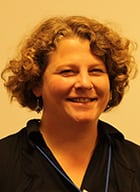 Guest blogger Jessica Juliuson is a senior training and technical assistance associate at Education Development Center, Inc. (EDC), where she supports districts and schools in making systemic changes to ensure youth acquire the skills and knowledge they need to become productive members of the workforce. In this post, originally published on EDC’s Learning & Teaching Blog, Jessica shares insights on the pivotal role that close collaborations between employers and schools plays in supporting college and career success. Follow EDC on Twitter at @EDCtweets.
Guest blogger Jessica Juliuson is a senior training and technical assistance associate at Education Development Center, Inc. (EDC), where she supports districts and schools in making systemic changes to ensure youth acquire the skills and knowledge they need to become productive members of the workforce. In this post, originally published on EDC’s Learning & Teaching Blog, Jessica shares insights on the pivotal role that close collaborations between employers and schools plays in supporting college and career success. Follow EDC on Twitter at @EDCtweets.
“Kids my age need to know why. If you ask a kid to take out the garbage, they are going to ask why. If you tell a kid he needs to learn the three gas laws, they are going to ask why. When they don’t get an answer to that ‘why,’ they are not going to want to learn. They are not going to remember, they are not going to absorb, and they are not going to care about it at the end of the school day, or at the end of the test.”
Alex Beebe, Jeffersontown High School, Louisville, KY
“Why are we doing this?” In the end, how our youth answer this question will have the most direct impact on the skills and knowledge they retain and their success in post-secondary education and the workforce. Unfortunately, the answer to “Why are we doing this?” can be elusive. Even teachers do not always know how to respond, how to connect youths’ learning to the world outside of school, and, most importantly, how to connect learning to youths’ hopes and dreams for their futures.
Nationwide, the businesses that are right outside the schools in youths’ communities can play a pivotal role in helping teachers and youth answer this question. Employers have keen insights into some of the important “why’s” of learning—specifically viewed through the lens of what it takes to be prepared or unprepared, to succeed or to struggle, and to make a mark and have an impact in the workplace and in the world. Indeed, work-based learning (WBL) has received increased attention in recent years, as evidenced by: increased state requirements for career technical education (CTE) pathways and certifications in states like Kentucky; the popularity of approaches like the California Partnership Academies; and the promising evidence emerging in support of the career academy model. This popularity is bolstered by growing amounts of data indicating improved outcomes for students who learn in the career academy context, including improved earnings potential for students considered most at-risk for dropping out.
At EDC, we have collaborated on the development of a framework and tools that engage and support employer partners in working strategically and efficiently with schools. Using a Problem Based Case Learning (PBCL) approach, we work with school and district leadership and employer partners to develop a plan for instructional collaboration. My colleague Ilene Kantrov described the potential of this approach in a recent white paper. While each school’s plan may look different according to its unique context, all plans include a sequence of sustained professional development experiencesincluding teacher externships, instructional planning tools and processes for developing integrated projects based on authentic employer challenges, and strategies for engaging employers directly with students to support them in tackling open-ended problems and developing solutions.
In Louisville, teacher teams participated in a week-long externship experience designed and facilitated by EDC and Ford NGL in conjunction with the Ford Louisville Assembly Plant. In the experience, the teacher teams explored a real problem that engineers had presented—the upcoming introduction of a new Ford model to the assembly line. Here’s how it played out:
- Teachers talked with engineers from many different sectors of the plant, learning how the change would affect their work and strategies they were using to plan for the adaptations they needed to make.
- Teachers returned to school to develop projects for their tenth grade students that included the cutting-edge content and skills they had seen used at the plant.
- Students engaged in time and motion studies to increase efficiency on assembly lines of their own design, and built robots that needed to hand off their contents to each other smoothly and without interruption.
- Students presented their creations to the engineers at the Ford plant, who gave them constructive questions and critiques to help them improve their designs.
- This school year, the Ford engineers are working directly with the teachers to help students make their high school campus more energy efficient.
Our work in Louisville and work that is just beginning in Michigan—in Detroit and surrounding suburbs—underscores how valuable it can be to build bridges between employers and schools. As they gain experience working with one another and develop meaningful working relationships, employers and schools become true partners with a shared investment in youth’s success. At EDC, we believe it is imperative for this to happen. Other organizations that focus on youth and workforce development, such as the Partnership for 21st Century Learning, concur, as do recent reports by the National Science Foundation and U.S. Department of Education. Yet it is not fast and simple to build strong, sustainable bridges.
It can be difficult to sustain funding for teacher development experiences such as externships, as well as to provide structures and time for teachers to apply their new learning to the classroom. Testing and rigid curriculum pacing can also be a roadblock. A math teacher that I worked with in Louisville told me, “I know my students will be excited by this kind of experience, but I don’t know how to plan it so it doesn’t disrupt the content I have to teach.” While employer partners can offer supports and resources so teachers don’t have to shoulder the burden themselves, they do not always have a clear pathway or process for engaging with schools. One Ford engineer in Detroit told me, “It can be frustrating to want to help but not know where to start. I have lots of ideas for experiences that I think would be great for kids, but I need the teachers to want to be part of it and I am not sure who I should be talking to.”
EDC has been working with Ford Motor Company Fund for over 15 years to come up with strategies to address these challenges. The Powered by Ford STEM Academies intentionally and explicitly build in this kind of employer collaboration as an expectation and sustained approach across the entire network, and the approach has big pay-offs for students and teachers. With the involvement and investment of industry partners, it becomes much easier for teachers to come up with quick and compelling answers when youth ask, “Why am I doing this?” More importantly, youth are able to come up with quick, compelling answers to the question on their own. Says Jeffersontown High School senior James Chestnut, “I wanted to get this experience before I go off to college, and then when I come back, I’ll have some open doors for me and all kinds of different paths I can take. That’s really exciting.”





